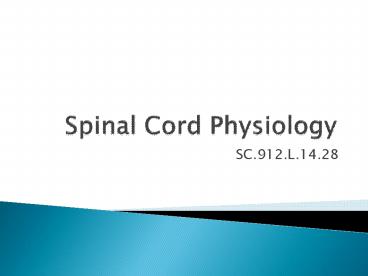Spinal Cord Physiology - PowerPoint PPT Presentation
1 / 9
Title:
Spinal Cord Physiology
Description:
SC.912.L.14.28 What does the spinal cord do? White matter nerve impulse conduction Grey matter receives and integrates incoming and outgoing information Axons ... – PowerPoint PPT presentation
Number of Views:749
Avg rating:3.0/5.0
Title: Spinal Cord Physiology
1
Spinal Cord Physiology
- SC.912.L.14.28
2
Essential Question
- What does the spinal cord do?
3
Functions
- White matter nerve impulse conduction
- Grey matter receives and integrates incoming
and outgoing information
4
Descending Tracts
- Axons within the descending tracts control the
smooth muscles of internal organs and the
skeletal muscles of the arms and legs. - Neural signals follow specific pathways. In the
case of the descending tracts axons from the
brain synapse with cell bodies in the spinal cord
which then send impulses out to the rest of the
body.
5
Ascending Tracts
- Sensory signals from the skin, extrmeties and
internal organs are carried via pahtways in the
ascending tracts. - Most these signals are relayed to the brain. Some
activate reflexes which are controlled by
interneurons in the spinal cord and are not
addressed by the brain.
6
Spinal Cord Segments
- Each spinal cord segment marks where spinal
nerves emerge from the cord to connect with
specific regions of the body.
7
Regions of Control
- Cervical spinal nerves (C1 to C8) control signals
to the back of the head, the neck and shoulders,
the arms and hands, and the diaphragm. - Thoracic spinal nerves (T1 to T12) control
signals to the chest muscles, some muscles of the
back, and parts of the abdomen. - Lumbar spinal nerves (L1 to L5) control signals
to the lower parts of the abdomen and the back,
the buttocks, some parts of the external genital
organs, and parts of the leg. - Sacral spinal nerves (S1 to S5) control signals
to the thighs and lower parts of the legs, the
feet, most of the external genital organs, and
the area around the anus.
8
Spinal cord injury
- May be damaged by tumors, blood clots, wounds,
trauma, or herniated disks. - Paralysis may occur depending on the extent of
the injury.
9
Did you know???

